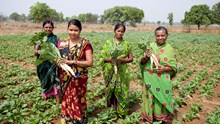
In India, particularly in arid and semi-arid regions, sheep farming has been a cornerstone of rural life for centuries. Whether it's a shepherd guiding his flock across vast open fields or a small-scale farmer tending to a few sheep behind his home, these animals have long been an integral part of rural livelihoods. However, with the growing demand for mutton and wool, this age-old tradition is evolving into a profitable business opportunity.
Sheep farming offers several advantages- it requires relatively low investment, is easy to manage, and thrives in areas where traditional crops may struggle. For small and marginal farmers, women's self-help groups, and even landless laborers, sheep farming presents a unique opportunity to generate a steady income throughout the year, while contributing to the local economy.
Why Sheep Rearing is a Wise Choice
Sheep farming is one of the most profitable and simplest animal husbandry practices for Indian farmers. Here's why:
-
Low Initial Investment: you don’t need a large farm or a costly shed to begin. A basic covered area is enough to keep them safe from rain and sun. The animals themselves are affordable, and you can begin a small flock with 10–20 sheep.
-
Less Labour, More Profit: Sheep require less day-to-day attention compared to poultry or cattle. They can be allowed to graze freely in the open. Even school-going children or elderly family members can handle them with ease.
-
Multi-purpose Income: Sheep give you meat, wool, and manure. Certain breeds also offer milk. Wool can be sold to local dealers or wool industries, and manure enhances soil fertility for your crops.
-
Good Market Demand: Mutton is enjoyed by nearly every community in India. There is no religious constraint, so it sells well everywhere. As the price of mutton keeps increasing, farmers receive good returns.
-
Hardy and Adaptive: Sheep are hardy animals. They can live in dry and stony lands where even goats or cows may not survive. They feed on various types of weeds and grass, keeping your fields clean as well.
-
Natural Fertilization of Soil: Maintaining "penning"—overnight grazing of sheep in fields—results in natural soil enrichment. Their dropping contributes to organic matter, lessening the requirement for chemical fertilizers.
Breeding and Production
A healthy female sheep or ewe delivers 1–2 lambs in every cycle. If fed well and cared for, breeding is possible twice annually. This means your flock will double rapidly—10 ewes can give rise to 30–40 sheep within 2 years.
Sheep achieve market weight (approximately 22–30 kg meat weight) in approximately 8–10 months. You can sell lambs as meat or retain a few females to increase your flock.
Feeding and Grazing
Sheep mostly feed on grass, weeds, shrubs, and crop residues. Sheep may graze on open lands, fallow land, or roadside plants. They are thus suited for low-rainfall or poor-soil areas.
You may also give them dry fodder such as hay, crop husk, and tree leaves. In dry periods, providing salt-mineral licks and a little grain (such as maize or gram husk) keeps them healthy and weighed.
Fresh drinking water should always be available, particularly during summer.
Housing and Care
Sheep don't require luxurious housing, a simple thatched shed or tin-roofed structure does help keep them out of rain and cold. Proper drainage, clean bedding, and ventilation are necessary to ensure their good health.
Vaccinating the flock regularly against most common diseases, such as PPR (Peste des Petits Ruminants) and enterotoxaemia, is good. And deworming every 2–3 months is necessary for good growth and reproduction.
Manure for Farming
Sheep droppings make great organic fertilizer. A single adult sheep produces between 1 tonne of manure in a year. If you let your flock overnight in the field, your soil becomes naturally more fertile which results in increased crop yield. This makes sheep farming an ideal complement to dryland or mixed farming systems.
Income Possibility
Let's consider an example. Assume you have 10 ewes(female sheep) and 1 ram (male sheep). You may expect at least 15–20 lambs in one year. Selling one lamb at Rs. 6,000–Rs. 8,000 (depending on the weight and age) can give you Rs. 1–1.5 lakh a year. This doesn't include the revenue from manure or wool sales. With gradual expansion, you can double this revenue within 2–3 years while keeping the expenses low.
Sheep farming is not just a tradition, it's a smart livelihood choice for the modern farmer. With increasing market demand, increasing mutton prices, and low input costs, it provides guaranteed income with little risk. It is appropriate for India's drylands, tribal belts, and even hills. Above all, it enables farmers to be self-sufficient, without relying on costly inputs or large land holdings.
For marginal farmers looking to boost their income or for landless laborers aspiring to acquire a secure way of living, sheep rearing may be the first step toward a more prosperous and sustainable rural life.
















